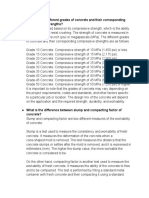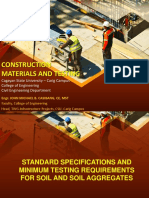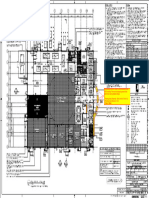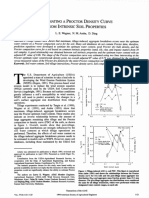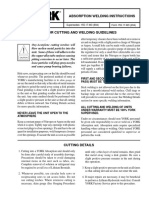Uniformity Test of Concrete PDF
Uniformity Test of Concrete PDF
Uploaded by
Tayyab AchakzaiCopyright:
Available Formats
Uniformity Test of Concrete PDF
Uniformity Test of Concrete PDF
Uploaded by
Tayyab AchakzaiOriginal Title
Copyright
Available Formats
Share this document
Did you find this document useful?
Is this content inappropriate?
Copyright:
Available Formats
Uniformity Test of Concrete PDF
Uniformity Test of Concrete PDF
Uploaded by
Tayyab AchakzaiCopyright:
Available Formats
UNIFORMITY OF CONCRETE TXDOT DESIGNATION: TEX-472-A
Test Procedure for
UNIFORMITY OF CONCRETE
Texas
Department
TxDOT Designation: Tex-472-A of Transportation
Effective Dates: February 2005–June 2008
1. SCOPE
1.1 Use this method to evaluate the uniformity of a batch of concrete. Six concrete properties
are determined from each of two samples, compared to each other, and the property
differences are determined. Except for editorial differences, this procedure is identical to
the Annex of ASTM C 94.
1.2 The values given in parentheses (if provided) are not standard and may not be exact
mathematical conversions. Use each system of units separately. Combining values from
the two systems may result in nonconformance with the standard.
2. SAMPLING
2.1 Sample the fresh concrete in accordance with Tex-407-A. A sample should be
approximately 2.0 ft3 or 300 lbs. (0.06 m3 or 150 kg).
3. APPARATUS
3.1 Standard U.S. sieve, 4.75 mm (No. 4), meeting the requirements of Tex-907-K.
4. PROCEDURE
4.1 Batch and mix concrete per the Department’s Standard Specifications for Construction
and Maintenance of Highways, Streets, and Bridges, Item 421.
4.2 Take the first sample of concrete at approximately 15% of the total batch discharge. Take
the second sample of concrete at approximately 85% of the total batch discharge.
Note 1—Obtain the samples within a mandatory elapsed time of 15 min.
4.3 For each sample, determine:
4.3.1 Unit Weight of Concrete and Coarse Aggregate Content, P:
4.3.1.1 Determine unit weight in accordance with Tex-417-A.
CONSTRUCTION DIVISION 1–3 02/05–06/08
UNIFORMITY OF CONCRETE TXDOT DESIGNATION: TEX-472-A
4.3.1.2 Wet sieve the contents of the unit weight container thru a No. 4 (4.75 mm) sieve. Wash
all the mortar away from the coarse aggregate, using as much water as needed.
4.3.1.3 Bring the coarse aggregate to saturated surface-dry (SSD) condition in accordance with
Tex-403-A, using the amount of coarse aggregate that has been wet sieved as the
laboratory test size.
4.3.1.4 Once the coarse aggregate reaches the SSD condition, immediately weigh and record as
"c" under Section 6.
4.3.1.5 Calculate Unit Mass, U, as shown in Section 6, of the coarse aggregate that has been
wet-sieved.
4.3.1.6 Determine the Specific Gravity, G, in accordance with Tex-403-A, of the coarse
aggregate that has been wet-sieved.
4.3.1.7 Calculate Coarse Aggregate Content, P, as shown in Section 6.
4.3.2 Air content, in accordance with Tex-414-A or Tex-416-A.
4.3.3 Slump, in accordance with Tex-415-A.
4.3.4 Seven-Day Compressive Strength:
4.3.4.1 Mold and cure a minimum of three cylinders per sample in accordance with Tex-447-A.
4.3.4.2 Determine the seven-day compressive strength in accordance with Tex-418-A.
4.3.5 Unit Weight of Air-Free Mortar, M, as shown in Section 6.
4.4 Compare the two samples and determine property differences.
5. UNIFORMITY REQUIREMENTS
5.1 Table 1 lists the maximum allowable differences for each of the six concrete properties
for the two samples.
Table 1—Uniformity Requirements
Concrete Property Maximum Allowable Difference
Unit Weight of Concrete 1.0 lb/ft.3 ( 16.0 kg/m3)
Air Content 1.0%
Slump:
For average slump of 4 in. or less 1 in.(25 mm)
For average slump greater than 4 in. and up to 6 in. 1.5 in. (40 mm)
Coarse aggregate content, P 6.0%
Unit Weight of the air free mortar, M 1.6%1
CONSTRUCTION DIVISION 2–3 02/05–06/08
UNIFORMITY OF CONCRETE TXDOT DESIGNATION: TEX-472-A
Table 1—Uniformity Requirements
Seven-day compressive strength 7.5%1
1. Based on the average of all test specimens
6. CALCULATIONS
6.1 Calculate percent weight of coarse aggregate in concrete and weight per unit volume of
air-free mortar:
U = 62.4 × G
P= c( b ) × 100
b−c
M=
⎛V × A c ⎞
V −⎜ + ⎟
⎝ 100 U ⎠
Where:
U = unit mass, lb./ft.3 (kg/m3)
P = percent weight of coarse aggregate in concrete, %
b = weight of concrete contained in the unit weight container, lb. (kg)
c = saturated-surface-dry weight of coarse aggregate retained on the No. 4 (4.75 mm)
sieve, using coarse aggregate from wet sieving the concrete in the unit weight
container, lb. (kg)
M = weight per unit volume of air-free mortar, lb./ft.3 (kg/m3)
V = volume of the unit weight container, ft.3 (m3)
A = air content of concrete mixture, %
G = specific gravity of coarse aggregate in saturated-surface-dry condition,
dimensionless.
CONSTRUCTION DIVISION 3–3 02/05–06/08
You might also like
- Car Park Shade QatarSat PDFDocument2 pagesCar Park Shade QatarSat PDFAnonymous 94TBTBRks50% (2)
- Concrete Quality Technical ManagerDocument2 pagesConcrete Quality Technical ManagerNaveed Shaheen0% (1)
- 211 R83-17 PDFDocument11 pages211 R83-17 PDFjun floresNo ratings yet
- SAES Q 001 Table ExposureDocument4 pagesSAES Q 001 Table ExposureKhurram ShehzadNo ratings yet
- Aramco ChecklistDocument1 pageAramco ChecklistTayyab AchakzaiNo ratings yet
- Muhammad Minhaj CV Document Control ManagerDocument4 pagesMuhammad Minhaj CV Document Control ManagerTayyab Achakzai100% (2)
- Diamond and CBN English 07Document26 pagesDiamond and CBN English 07Vk PrabakranNo ratings yet
- 5-Notes For Building Related Activities-2Document9 pages5-Notes For Building Related Activities-2Eshaal Noreen100% (1)
- Material ControlDocument3 pagesMaterial ControlChe ElleNo ratings yet
- CQP433F Batch Plants ObservationDocument3 pagesCQP433F Batch Plants ObservationjjsalcedNo ratings yet
- Core Knowledge For CIvil QCDocument35 pagesCore Knowledge For CIvil QCIslam Panhwar100% (1)
- ASTM C231 Type A - ChecklistDocument4 pagesASTM C231 Type A - ChecklistTienNo ratings yet
- Earth WorksDocument14 pagesEarth WorksJam100% (1)
- M o S For Grouting-01Document6 pagesM o S For Grouting-01civil.godfatherNo ratings yet
- Key - QC Buildings TestDocument4 pagesKey - QC Buildings TestKhurram ShehzadNo ratings yet
- 32 Bitumen MasticDocument4 pages32 Bitumen MasticArul Mozhi VarmanNo ratings yet
- SAIC-Q-1036 Raw Materials Sampling, Testing & Asphalt Mix Design ReviewDocument7 pagesSAIC-Q-1036 Raw Materials Sampling, Testing & Asphalt Mix Design ReviewAbdul HannanNo ratings yet
- P133I ConcreteDocument9 pagesP133I Concretekbldam100% (2)
- Civil Test: NameDocument6 pagesCivil Test: NamePrince JoseNo ratings yet
- Aramco Qestion PaperDocument16 pagesAramco Qestion Paperfootb3146No ratings yet
- Q.C Aramco Test - 2Document20 pagesQ.C Aramco Test - 2pakturkrings123100% (1)
- Saudi Aramco Inspection ChecklistDocument10 pagesSaudi Aramco Inspection ChecklistAbdul HannanNo ratings yet
- Intro & Subgrade CompactionDocument27 pagesIntro & Subgrade CompactionCarlos Ramos GuerraNo ratings yet
- Aggregate PaperDocument13 pagesAggregate PaperSafdar HasnainNo ratings yet
- 03 30 00 Cast in Place Concrete ChristensonDocument9 pages03 30 00 Cast in Place Concrete ChristensonHendra Rikardo TobingNo ratings yet
- 01-Battery Room Ceramic Floor TilesDocument1 page01-Battery Room Ceramic Floor TilesJoey RomeroNo ratings yet
- QC Notes Revised 12 PagesDocument12 pagesQC Notes Revised 12 PagesTaimoor Abbass100% (1)
- Astm C702 C702M 18Document2 pagesAstm C702 C702M 18maritaNo ratings yet
- Interview Questions (Concrete Related)Document43 pagesInterview Questions (Concrete Related)Muhammad AhmadNo ratings yet
- Awais Inspector-PaintingDocument6 pagesAwais Inspector-PaintingMohammed GaniNo ratings yet
- 199 Materials Engineer Test ReviewerDocument48 pages199 Materials Engineer Test ReviewerJanelle RoweNo ratings yet
- Compressive Strength of Concrete CubesDocument4 pagesCompressive Strength of Concrete CubesNawab Khan Virk100% (1)
- Initial Survey LATEST 2022 MARDocument6 pagesInitial Survey LATEST 2022 MARDelta akathehuskyNo ratings yet
- Civil SATIPs, SAICs and SATRsDocument8 pagesCivil SATIPs, SAICs and SATRsMUHAMMAD BILALNo ratings yet
- Logbook Data (Dec 13) 09Document18 pagesLogbook Data (Dec 13) 09Amit shahNo ratings yet
- As Soon As The Contract Is Awarded,: Further For PO PlacementDocument9 pagesAs Soon As The Contract Is Awarded,: Further For PO PlacementMohammed SibghatullaNo ratings yet
- ConcreteDocument28 pagesConcreteAsghar Hussain ShahNo ratings yet
- Coating System and Approved Data SeetDocument31 pagesCoating System and Approved Data SeetMdinamullahNo ratings yet
- SAIC-H-1002 - Coatings and Repair Materials Receiving, InspectionDocument2 pagesSAIC-H-1002 - Coatings and Repair Materials Receiving, InspectionzuknesedriNo ratings yet
- 7 - Hardened PropertiesDocument51 pages7 - Hardened Propertiestahsinkabir4590No ratings yet
- Saic-Q-1037 Sub-Base &aggregate Base Course Reciving InspectionDocument2 pagesSaic-Q-1037 Sub-Base &aggregate Base Course Reciving InspectionAbdul HannanNo ratings yet
- Saes A 114Document2 pagesSaes A 114Nino Celso AstilleroNo ratings yet
- 3-Civil Inspection Technical Test ReportDocument22 pages3-Civil Inspection Technical Test ReportEshaal NoreenNo ratings yet
- Saic A 1002Document2 pagesSaic A 1002pradeepthalava97No ratings yet
- Standard Specifications and Minimum TestingDocument19 pagesStandard Specifications and Minimum TestingCarjez LoveNo ratings yet
- ACI 311.5R-97 Guide For Concrete Plant Inspection and Field Testing of Ready-Mixed ConcreteDocument5 pagesACI 311.5R-97 Guide For Concrete Plant Inspection and Field Testing of Ready-Mixed ConcretenathanNo ratings yet
- SACIC-Q-1022 Rev.01 Precast Concrete Sampling, Testing & Placement InspectionDocument4 pagesSACIC-Q-1022 Rev.01 Precast Concrete Sampling, Testing & Placement InspectionMuhammad AbrarNo ratings yet
- QCQADocument11 pagesQCQArakanalammari505100% (1)
- 09-SAMSS-068 Qualification Requirements For Coal Tar Epoxy in Buried or Immersion Services (APCS-3) For Steel and ConcreteDocument7 pages09-SAMSS-068 Qualification Requirements For Coal Tar Epoxy in Buried or Immersion Services (APCS-3) For Steel and ConcreteAbdul HannanNo ratings yet
- Tests in Civil EngineeringDocument4 pagesTests in Civil Engineeringezradural99100% (1)
- Concrete Field TechnicianDocument242 pagesConcrete Field TechnicianZarah PanesNo ratings yet
- ASTM D2041 aashto T209 ефект процент битума PDFDocument4 pagesASTM D2041 aashto T209 ефект процент битума PDFanon_711474514No ratings yet
- Grading AggregatesDocument1 pageGrading AggregatesIsaiahogedaNo ratings yet
- Saudi Aramco Inspection Checklist: Masonry Materials Receiving and Storage Inspection SAIC-M-1007 1-Nov-09 CivilDocument2 pagesSaudi Aramco Inspection Checklist: Masonry Materials Receiving and Storage Inspection SAIC-M-1007 1-Nov-09 CivilWaleed MedhatNo ratings yet
- Chapter 9: Evalua On and Acceptance of Hardened ConcreteDocument9 pagesChapter 9: Evalua On and Acceptance of Hardened ConcreteGaneshNo ratings yet
- 009 PAINTING AND COATING OF CONCRETE FOUNDATION LIGHTING POLES Rev. 01Document9 pages009 PAINTING AND COATING OF CONCRETE FOUNDATION LIGHTING POLES Rev. 01Marwa FaroukNo ratings yet
- SAES-Q-001 SAES-Q-001: Criteria For Design and Construction of Concrete StructuresDocument6 pagesSAES-Q-001 SAES-Q-001: Criteria For Design and Construction of Concrete StructuresAbdul HannanNo ratings yet
- Concrete Batch PlantDocument7 pagesConcrete Batch Plantراجہ شہزاد انور100% (1)
- Quality Circles in Which Groups of Workers Meet Regularly To Make Suggestions ForDocument11 pagesQuality Circles in Which Groups of Workers Meet Regularly To Make Suggestions Forghenoel26No ratings yet
- Qaqc Inspector QuestionaireDocument4 pagesQaqc Inspector QuestionaireNiño Celso AstilleroNo ratings yet
- Appendix GDocument1 pageAppendix GDelta akathehuskyNo ratings yet
- DFT Bitumen Paint Check ListDocument1 pageDFT Bitumen Paint Check ListMohammed ArishNo ratings yet
- SAES-Q-012: PCI-MNL-120 PCI-MNL-122 Minimum 35 Mpa (5,000 Psi) Minimum 35 Mpa (5,000 Psi)Document5 pagesSAES-Q-012: PCI-MNL-120 PCI-MNL-122 Minimum 35 Mpa (5,000 Psi) Minimum 35 Mpa (5,000 Psi)Nino Celso Astillero100% (3)
- Uniformity Test of ConcreteDocument3 pagesUniformity Test of Concreterajam1997100% (1)
- 4-WP-J asphalt worksDocument3 pages4-WP-J asphalt worksTayyab AchakzaiNo ratings yet
- masterseal 610_tdsDocument3 pagesmasterseal 610_tdsTayyab AchakzaiNo ratings yet
- APOC concrete estimationDocument1 pageAPOC concrete estimationTayyab AchakzaiNo ratings yet
- t80-R-pp-476402-001 - Rev B Floor Plan Central Control Building (Landscaping)Document1 paget80-R-pp-476402-001 - Rev B Floor Plan Central Control Building (Landscaping)Tayyab AchakzaiNo ratings yet
- Daily Report 29-2-2020Document2 pagesDaily Report 29-2-2020Tayyab AchakzaiNo ratings yet
- 4245 Aa DC 1362502004 Is00Document1 page4245 Aa DC 1362502004 Is00Tayyab AchakzaiNo ratings yet
- 4245 Aa DC 1362502002 Is00Document1 page4245 Aa DC 1362502002 Is00Tayyab AchakzaiNo ratings yet
- Nitocote NT550: Flexible Protecting Coating, Based On A Hybrid Resin SystemDocument3 pagesNitocote NT550: Flexible Protecting Coating, Based On A Hybrid Resin SystemTayyab AchakzaiNo ratings yet
- Sandwich Panel SepDocument7 pagesSandwich Panel SepTayyab AchakzaiNo ratings yet
- Quantity IncompleteDocument3 pagesQuantity IncompleteTayyab AchakzaiNo ratings yet
- Brochure Polycarbonate SheetsDocument6 pagesBrochure Polycarbonate SheetsTayyab AchakzaiNo ratings yet
- Material Inspection Request (MIR) : Fr-QC-17-00Document1 pageMaterial Inspection Request (MIR) : Fr-QC-17-00Tayyab AchakzaiNo ratings yet
- Ir Log - EasternDocument279 pagesIr Log - EasternTayyab AchakzaiNo ratings yet
- Saic Q 1005Document3 pagesSaic Q 1005Tayyab AchakzaiNo ratings yet
- Key Plan: New Car Parking BuildingDocument1 pageKey Plan: New Car Parking BuildingTayyab AchakzaiNo ratings yet
- Aramco Civil ReviewerDocument10 pagesAramco Civil ReviewerTayyab AchakzaiNo ratings yet
- 91-2628 Estimating A Proctor Density Curve From Intrinsic Soil PropertiesDocument5 pages91-2628 Estimating A Proctor Density Curve From Intrinsic Soil PropertiesTayyab AchakzaiNo ratings yet
- Satip Q-012-01Document10 pagesSatip Q-012-01Tayyab Achakzai100% (1)
- Saudi Aramco Test Report: Internal Tank Bottom Testing 30-Oct-17 CP-SATR-X-3205Document8 pagesSaudi Aramco Test Report: Internal Tank Bottom Testing 30-Oct-17 CP-SATR-X-3205Tayyab AchakzaiNo ratings yet
- GaN HEMTs - Advantages Opportunities and Challenges PDFDocument60 pagesGaN HEMTs - Advantages Opportunities and Challenges PDFghatakp2069No ratings yet
- Simple Chemistry PBL 2.0 During PKPBDocument4 pagesSimple Chemistry PBL 2.0 During PKPBAryanaNo ratings yet
- Fabrication, Setup and Maintance of An AquariumDocument13 pagesFabrication, Setup and Maintance of An AquariumpoorvagangauNo ratings yet
- CAD PortfolioDocument17 pagesCAD Portfoliors7466383No ratings yet
- Genapol Ba 040Document1 pageGenapol Ba 040malek kaanicheNo ratings yet
- 1science5 Week 1Document12 pages1science5 Week 1Annie LouNo ratings yet
- Absorption Welding Instructions: ServiceDocument8 pagesAbsorption Welding Instructions: ServiceArshad MahmoodNo ratings yet
- Environment HazardDocument25 pagesEnvironment Hazardkimthanh070402100% (1)
- Vital Enset FiberDocument98 pagesVital Enset Fiberasemamaw damtie0% (1)
- CH 7 ExoDocument2 pagesCH 7 ExoHoussam Eddine BENLOUNASSENo ratings yet
- Api 577-5Document17 pagesApi 577-5muhammadazhar100% (2)
- Plasmarc Accessories: Remote Hand Switches Torch Guide KitsDocument2 pagesPlasmarc Accessories: Remote Hand Switches Torch Guide KitscarlosNo ratings yet
- Week 2 - Material Balance Single UnitDocument44 pagesWeek 2 - Material Balance Single UnitAnnisah MardiyyahNo ratings yet
- ATL CatalogDocument40 pagesATL CatalogFranciscoNo ratings yet
- Architectural MetalsDocument7 pagesArchitectural MetalsbrunizzaNo ratings yet
- Fine Coal: Challenges inDocument406 pagesFine Coal: Challenges inFaisal HzNo ratings yet
- GIN Pole DT0501024.4I - S0000 C: Alculation ReportDocument17 pagesGIN Pole DT0501024.4I - S0000 C: Alculation Reportnithilan msNo ratings yet
- Single Use Technologies Green Fact SheetDocument3 pagesSingle Use Technologies Green Fact SheetCampaign MediaNo ratings yet
- Lecture 3 Plant NutritionDocument72 pagesLecture 3 Plant NutritionGitta Lakshita AnggariniNo ratings yet
- Different Types of Dyeing ProcessDocument12 pagesDifferent Types of Dyeing ProcessNguyễn Huy CườngNo ratings yet
- Lenntech: 35 Frame Plunger PumpDocument4 pagesLenntech: 35 Frame Plunger PumpGeovani sampayoNo ratings yet
- Cambridge IGCSE: Combined Science 0653/12Document16 pagesCambridge IGCSE: Combined Science 0653/12annwong85No ratings yet
- SDS 131168 Er6 Bat 01012021 enDocument6 pagesSDS 131168 Er6 Bat 01012021 enRoberto SolísNo ratings yet
- Exercise - III: Subjective Level-IDocument6 pagesExercise - III: Subjective Level-IRishabh AgarwalNo ratings yet
- GL XX Primetals Gear Oil SeriesDocument3 pagesGL XX Primetals Gear Oil SeriesChérubinNo ratings yet
- Fea SW PDFDocument480 pagesFea SW PDFHomer Silva100% (4)
- Accelerated Ageing Tests of Vulcanized Rubber: Bpri Brussels, November 25 2009Document34 pagesAccelerated Ageing Tests of Vulcanized Rubber: Bpri Brussels, November 25 2009Daria D'souzaNo ratings yet
- Cardia Biohybrid™ H-M01Document2 pagesCardia Biohybrid™ H-M01Xuân Giang NguyễnNo ratings yet




























